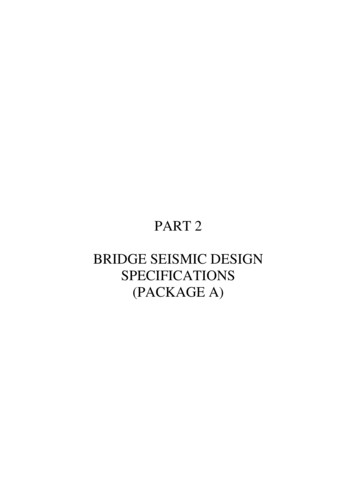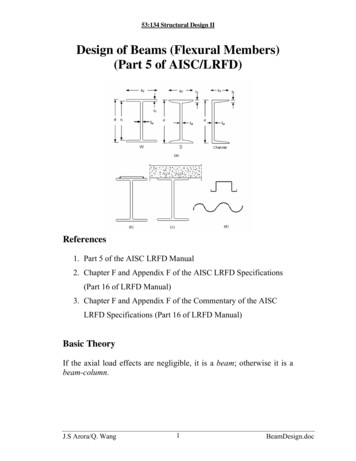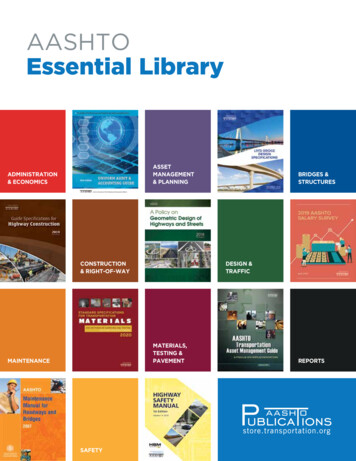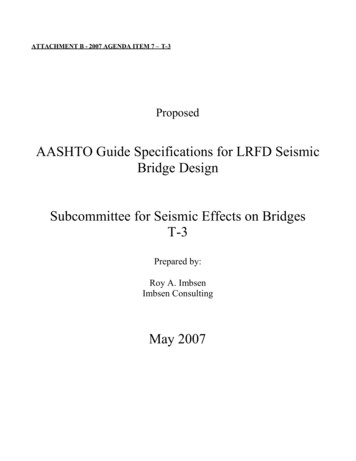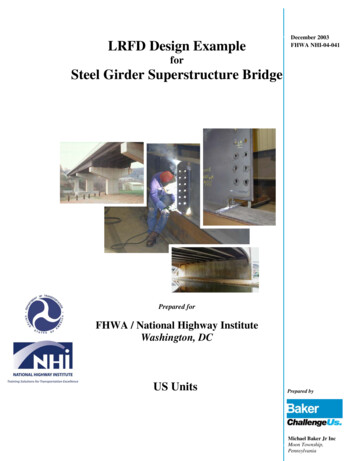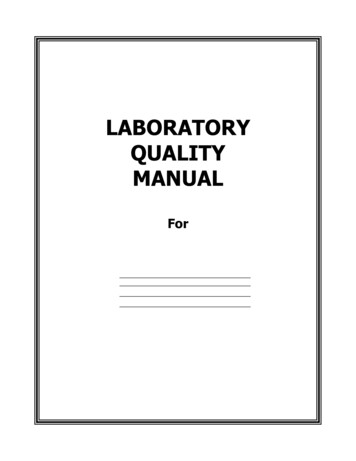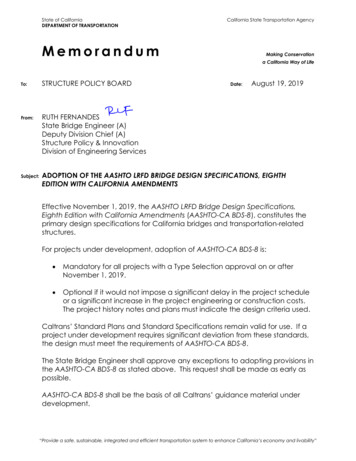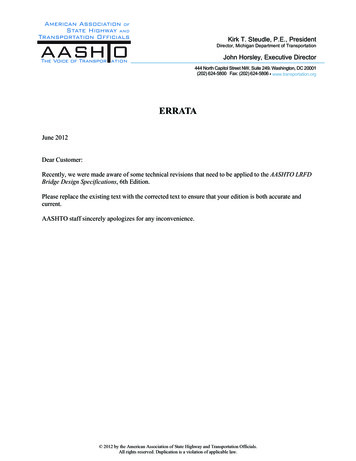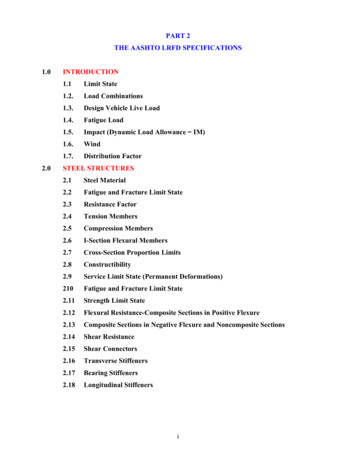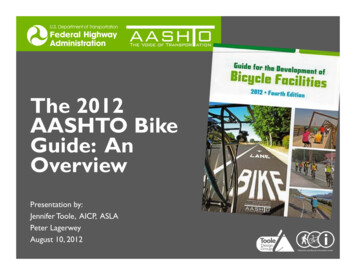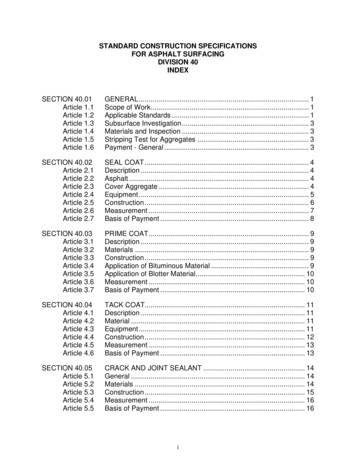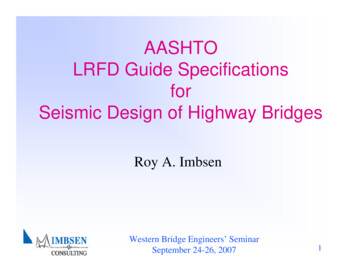
Transcription
AASHTOLRFD Guide SpecificationsforSeismic Design of Highway BridgesRoy A. ImbsenWestern Bridge Engineers’ SeminarSeptember 24-26, 20071
Presentation Topics Background-AASHTO LRFD Guide Specifications Excerpts selected from the Guide Specifications AASHTO T-3 Committee recent activitiessupporting adoption as a Guide Specification Current status Planned activities post-adoption ConclusionsWestern Bridge Engineers’ SeminarSeptember 24-26, 20072
AASHTO T-3 Working Group that definedthe objectives and directed the project Rick Land, CA (Past chair) Harry Capers, NJ (Past Co-chair) Richard Pratt, AK (Current chair) Kevin Thompson, CA (Current Co-chair) Ralph Anderson, IL Jugesh Kapur, WA Ed Wasserman, TN Paul Liles, GAWestern Bridge Engineers’ SeminarSeptember 24-26, 20073
Project Phases 2002 AASHTO T-3 Committee Meeting 2003 MCEER/FHWA––Task F3-4 Road MapTask F3-5 Suggested Approach 2004 NCHRP 20-07/Task 193 AASHTO Guide Specificationsfor LRFD Seismic Bridge Design AASHTO T-3 Committee and Volunteer States––2006 Trial Designs2007 Technical Review 2007 AASHTO Adoption as a Guide Specification with thecontinuous support and guidance of the T-3 CommitteeWestern Bridge Engineers’ SeminarSeptember 24-26, 20074
Overall T-3 Project Objectives Assist T-3 Committee in developing a LRFDSeismic Design Specification using availablespecifications and current research findings Develop a specification that is user friendly andimplemental into production design Complete six tasks specifically defined by theAASHTO T-3 Committee, which were based onthe NCHRP 12-49 review commentsWestern Bridge Engineers’ SeminarSeptember 24-26, 20075
Stakeholders TableIAI Team(as needed)T-3 Working GroupRoy Imbsen, IAIRoger Borcherdt, USGSPo Lam, EMIE. V. Leyendecker, USGSLee Marsh, Berger/AbamRandy Cannon, formerlySCDOTRick Land, CA (Past chair)Harry Capers, NJ(Past Co-chair)Richard Pratt, AK(Current chair)Kevin Thompson, CA(Current Co-chair)Ralph Anderson, ILJugesh Kapur, WAEd Wasserman, TNPaul Liles, GATechnical Review Panel(to be invited)George Lee, MCEER, ChairRick Land, T-3 ChairGeoff Martin, MCEERJoe Penzien, HSRC, EQ V-teamJohn Kulicki, HSRCLes Youd, BYUJoe Wang, Parsons, EQ V-teamLucero Mesa, SCDOT V-teamWestern Bridge Engineers’ SeminarSeptember 24-26, 20076
THE MEMBERS OF THETECHNICAL REVIEW TEAM MARK MAHAN, CA DOT (TEAM LEADER)ROY A. IMBSEN, IMBSEN CONSULTINGELMER MARX, AK DOT & PFJAY QUIOGUE, CA DOTCHRIS UNANWA, CA DOTFADEL ALAMEDDINE, CA DOTCHYUAN-SHEN LEE, WA STATE DOTSTEPHANIE BRANDENBERGER, MT DOTDANIEL TOBIAS, IL DOTDERRELL MANCEAUX, FHWALEE MARSH, BERGER/ABAMWestern Bridge Engineers’ SeminarSeptember 24-26, 20077
THE STATES WHO PERFORMEDTHE TRIAL DESIGNS TANANEVADAOREGONTENNESSEEWASHINGTON STATEWestern Bridge Engineers’ SeminarSeptember 24-26, 20078
Support MCEER/FHWA “Seismic Vulnerability of theHighway System” Task F3-4 AASHTO T-3Support NCHRP 20-07/Task 193 Updating“Recommended LRFD Guidelines for SeismicDesign of Highway Bridges” AASHTO T-3 CommitteeWestern Bridge Engineers’ SeminarSeptember 24-26, 20079
Background-NCHRP 20-07Task 6 Report (1.1) Review Reference Documents Finalize Seismic Hazard Level Expand the Extent of the No-Analysis Zone Select the Most Appropriate Design Procedure forSteel Bridges Recommend Liquefaction Design Procedure Letter Reports for Tasks 1-5 (Ref. NCHRP 20-07/Task193 Task 6 Report for Updating “RecommendedLRFD Guidelines for Seismic Design of HighwayBridges” Imbsen & Associates, Inc., of TRC )Western Bridge Engineers’ SeminarSeptember 24-26, 200710
Western Bridge Engineers’ SeminarSeptember 24-26, 200711
Table of Contents 1. Introduction 2. Symbols and Definitions 3. General Requirements 4. Analysis and Design Requirements 5. Analytical Models and Procedures 6. Foundation and Abutment Design Requirements 7. Structural Steel Components 8. Reinforced Concrete Components Appendix A – Rocking Foundation Rocking AnalysisWestern Bridge Engineers’ SeminarSeptember 24-26, 200712
Table of Contents 1. Introduction 1.1 Background (NCHRP 20-07/Task 193 Task 6 Report) 2. Symbols and Definitions3. General Requirements4. Analysis and Design Requirements5. Analytical Models and Procedures6. Foundation and Abutment Design Requirements7. Structural Steel Components8. Reinforced Concrete ComponentsAppendix A Foundation Rocking AnalysisWestern Bridge Engineers’ SeminarSeptember 24-26, 200713
Background Task 2 - SeismicHazard Level (1.1)Recommended approach to addressing the seismic hazard: Design against the Effects Ground Shaking Hazard Selection of a Return Period for Design less than 2500 Years Inclusion of the USGS 2002 Update of the National SeismicHazard Maps Effects of Near Field and Fault Rupture to be addressed in afollowing Task Displacement Based Approach with both Design SpectralAcceleration and corresponding Displacement Spectra provided Hazard Map under the control of AASHTO with each Statehaving the option to Modify or Update their own State Hazardusing the most recent Seismological StudiesWestern Bridge Engineers’ SeminarSeptember 24-26, 200714
Background Task 2-Seismic Hazard(1.1)Seismic Hazard Practice can be best illustrated in lookingat the following sources: NEHRP 1997 Seismic Hazard PracticeCaltrans Seismic Hazard PracticeNYCDOT and NYSDOT Seismic Hazard PracticeNCHRP 12-49 Seismic Hazard PracticeSCDOT Seismic Hazard PracticeSite-Specific Hazard Analyses Conducted for CriticalBridgesWestern Bridge Engineers’ SeminarSeptember 24-26, 200715
Background Seismic Hazard forNormal Bridges (1.1) Selection of a lower return period for Design is madesuch that Collapse Prevention is not compromisedwhen considering large historical earthquakes. A reduction can be achieved by taking advantage ofsources of conservatism not explicitly taken intoaccount in current design procedures. The sources of conservatism are becoming moreobvious based on recent findings from bothobservations of earthquake damage and experimentaldata.Western Bridge Engineers’ SeminarSeptember 24-26, 200716
Background Task 2-Sources ofConservatism (1.1)Source of ConservatismSafety FactorComputational vs. Experimental DisplacementCapacity of Components1.3Effective DampingDynamic Effect (i.e., strain rate effect)1.2 to 1.51.2Pushover Techniques Governed by First PlasticHinge to Reach Ultimate Capacity1.2 to 1.5Out of Phase Displacement at Hinge SeatAddressed in Task 3Western Bridge Engineers’ SeminarSeptember 24-26, 200717
Idealized Load – Deflection CurveConsideredin DesignWestern Bridge Engineers’ SeminarSeptember 24-26, 200718
Western Bridge Engineers’ SeminarSeptember 24-26, 200719
Design Approaches-Force-Displacement Division 1A and CurrentLRFD Specification Complete w/ service loadrequirements Elastic demand forces w/applied prescribed ductility“R” Ductile response is assumedto be adequate w/overification New 2007 Guide Specification Complete w/ service loadrequirements Displacements demands w/displacement capacity checksfor deformability Ductile response is assuredwith limitations prescribed foreach SDCWestern Bridge Engineers’ SeminarSeptember 24-26, 200720
Background Seismic HazardNormal Bridges (1.1)Two distinctly different aspects of the design processneed to be provided: An appropriate method to design adequate seatwidth(s) considering out of phase motion. An appropriate method to design the ductilesubstructure components without undue conservatismThese two aspects are embedded with different levels ofconservatism that need to be calibrated against the singlelevel of hazard considered in the design process.Western Bridge Engineers’ SeminarSeptember 24-26, 200721
Background Task 3Expand the No-Analysis Zone (1.1) At a minimum, maintain the number of bridges under the“Seismic Demand Analysis” by comparing ProposedGuidelines to AASHTO Division I-A. Develop implicit procedures that can be used reduce thenumber of bridges where “Seismic Capacity Analysis” needs to Δbe performed, This objective is accomplished byPidentifyingathreshold where an implicit procedures can be used (DriftCriteria, Column Shear Criteria). Identify threshold where “Capacity Design” shall be used. Thisobjective is achieved in conjunction with the “Seismic CapacityAnalysis” requirements.Western Bridge Engineers’ SeminarSeptember 24-26, 200722
Guidelines-GeneralSeismic Load Path and Affected ComponentsWestern Bridge Engineers’ SeminarSeptember 24-26, 200723
GuidelinesPerformance Criteria Type 1 – Design a ductile substructure with anessentially elastic superstructure. Type 2 – Design an essentially elasticsubstructure with a ductile superstructure. Type 3 – Design an elastic superstructure andsubstructure with a fusing mechanism at theinterface between the superstructure and thesubstructure.Western Bridge Engineers’ SeminarSeptember 24-26, 200724
GuidelinesPerformance Criteria For Type 3 choice, the designer shall assess theoverstrength capacity for the fusing interfaceincluding shear keys and bearings, then design for anessentially elastic superstructure and substructure. The minimum overstrength lateral design force shallbe calculated using an acceleration of 0.4 g or theelastic seismic force whichever is smaller. If isolation devices are used, the superstructure shallbe designed as essentially elastic.Western Bridge Engineers’ SeminarSeptember 24-26, 200725
Table of Contents 1. Introduction– 1.3 Flow Charts 2. Symbols and Definitions 3. General Requirements 4. Analysis and Design Requirements 5. Analytical Models and Procedures 6. Foundation and Abutment Design Requirements 7. Structural Steel Components 8. Reinforced Concrete Components Appendix A – Rocking Foundation Rocking AnalysisWestern Bridge Engineers’ SeminarSeptember 24-26, 200726
LRFDFlow ChartFig 1.3-1AWestern Bridge Engineers’ SeminarSeptember 24-26, 200727
LRFDFlow ChartFig 1.3-1BWestern Bridge Engineers’ SeminarSeptember 24-26, 200728
LRFDFlow Chart(Fig 1.3-5A )Western Bridge Engineers’ SeminarSeptember 24-26, 200729
Western Bridge Engineers’ SeminarSeptember 24-26, 200730
Table of Contents 1. Introduction 2. Symbols and Definitions 3. General Requirements 4. Analysis and Design Requirements 5. Analytical Models and Procedures 6. Foundation and Abutment Design Requirements 7. Structural Steel Components 8. Reinforced Concrete Components Appendix A – Rocking Foundation Rocking AnalysisWestern Bridge Engineers’ SeminarSeptember 24-26, 200731
Applicability (3.1) Design and Construction of New Bridges Bridges having Superstructures Consisting of:––––SlabBeamGirderBox Girder Spans less than 500 feetWestern Bridge Engineers’ SeminarSeptember 24-26, 200732
Performance Criteria (3.2) One design level for life safety Seismic hazard level for 7% probability ofexceedance in 75 years (i.e.,1000 year returnperiod) Low probability of collapse May have significant damage and disruption toserviceWestern Bridge Engineers’ SeminarSeptember 24-26, 200733
Table of Contents 1. Introduction 2. Symbols and Definitions 3. General Requirements3.3 Earthquake Resisting Systems 4. Analysis and Design Requirements 5. Analytical Models and Procedures 6. Foundation and Abutment Design Requirements 7. Structural Steel Components 8. Reinforced Concrete Components Appendix A – Rocking Foundation Rocking AnalysisWestern Bridge Engineers’ SeminarSeptember 24-26, 200734
Earthquake Resisting Systems-ERS(3.3) Required for SDC C and D Must be identifiable within the bridge system Shall provide a reliable and uninterrupted load path Shall have energy dissipation and/or restraint to controlseismically induced displacements Composed of acceptable Earthquake Resisting Elements(ERE)Western Bridge Engineers’ SeminarSeptember 24-26, 200735
ERS tern Bridge Engineers’ SeminarSeptember 24-26, 200736
ERS (3.3)PermissibleEarthquakeResistingElements thatRequire Owner’sApprovalWestern Bridge Engineers’ SeminarSeptember 24-26, 200737
Table of Contents 1. Introduction 2. Symbols and Definitions 3. General RequirementsSeismic Ground Shaking Hazard 4. Analysis and Design Requirements 5. Analytical Models and Procedures 6. Foundation and Abutment Design Requirements 7. Structural Steel Components 8. Reinforced Concrete Components Appendix A – Rocking Foundation Rocking AnalysisWestern Bridge Engineers’ SeminarSeptember 24-26, 200738
Seismic Hazard (3.4) 7% Probability of Exceedence in 75 Years AASHTO-USGS Technical Assistance Agreement to:––Provide paper mapsDevelop ground motion software Hazard maps for 50 States and Puerto Rico––––Conterminous 48 States-USGS 2002 mapsHawaii-USGS 1998 mapsPuerto Rico-USGS 2003 mapsAlaska-USGS 2006 maps Maps for Spectral Accelerations Site Class B–––Short period (0.2 sec.)Long period (1.0 sec.)Peak (PGA 0.0 sec.)Western Bridge Engineers’ SeminarSeptember 24-26, 200739
Seismic Hazard2-Point Methodfor re 3.4.1-1Western Bridge Engineers’ SeminarSeptember 24-26, 200740
Trial Design MO-2 (3.1)38'-10"8'-10"8'-10"8'-10"8'-10"8 21" SLAB3'-3" DEEPPS/PC I-GIRDERTYP3'-3"3'-3"x3'-6" BEAM3'-0" COLUMNS (TYP)13'-0"(TYP)ELV 026'-6"VARIES13 - #8(TYP)4'-0"ELV '-2" CIPCONC PILEW/STEELCASING, TYP9'-14" CIP (TYP)(13'x13'x4' PILE CAP)SECTION-INTERMEDIATE PIERSCALE: 1/16" 1'-0"Elevation of Intermediate PierWestern Bridge Engineers’ SeminarSeptember 24-26, 200741
BRG ABUT BBENT 2BENT 1BRG ABUT ATrial Design MO-2 (3.1)14"CIPCONC PILEW/STEELCASING, TYP13'-0"ELEVATION - MISSOURI SITE1' 40'Western Bridge Engineers’ SeminarSeptember 24-26, 200742
AASHTO/USGS Maps(3.4.1)Figure 3.4.1-2a Peak HorizontalGround Acceleration for theConterminous United States(Western) With 7 PercentProbability of Exceedance in75 Years (Approx. 1000 YearReturn Period).Western Bridge Engineers’ SeminarSeptember 24-26, 200743
AASHTO/USGS Maps (3.4.1)Western Bridge Engineers’ SeminarSeptember 24-26, 200744
LRFD SHTO/USGS MapsRegion 30.2 second periodLongitude 89.817o WestLatitude 36.000o NorthAcceleration 1.89gWestern Bridge Engineers’ SeminarSeptember 24-26, 200745
Site Effects Fv (3.4.2)Western Bridge Engineers’ SeminarSeptember 24-26, 200746
Seismic Hazard2-Point Methodfor DesignSpectrumConstruction(3.4)Western Bridge Engineers’ SeminarSeptember 24-26, 200747
Western Bridge Engineers’ SeminarSeptember 24-26, 200748
Western Bridge Engineers’ SeminarSeptember 24-26, 200749
Western Bridge Engineers’ SeminarSeptember 24-26, 200750
Western Bridge Engineers’ SeminarSeptember 24-26, 200751
Western Bridge Engineers’ SeminarSeptember 24-26, 200752
Western Bridge Engineers’ SeminarSeptember 24-26, 200753
Western Bridge Engineers’ SeminarSeptember 24-26, 200754
Western Bridge Engineers’ SeminarSeptember 24-26, 200755
Table of Contents 1. Introduction 2. Symbols and Definitions 3. General Requirements3.5 Seismic Design Category 4. Analysis and Design Requirements 5. Analytical Models and Procedures 6. Foundation and Abutment Design Requirements 7. Structural Steel Components 8. Reinforced Concrete Components Appendix A – Rocking Foundation Rocking AnalysisWestern Bridge Engineers’ SeminarSeptember 24-26, 200756
SDC Range of ApplicableAnalysis (3.5)Four Seismic Design Categories (SDC)A, B, C and D encompassing requirements for: Seismic Demand Analysis requirementSeismic Capacity Analysis requirementCapacity Design requirementLevel of seismic detailing requirement including fourtiers corresponding to SDC A, B, C and D Earthquake Resistant SystemWestern Bridge Engineers’ SeminarSeptember 24-26, 200757
SDC (3.5)Western Bridge Engineers’ SeminarSeptember 24-26, 200758
SDC A (3.5)Western Bridge Engineers’ SeminarSeptember 24-26, 200759
SDC B (3.5)Western Bridge Engineers’ SeminarSeptember 24-26, 200760
SDC C (3.5)Western Bridge Engineers’ SeminarSeptember 24-26, 200761
SDC D (3.5)Western Bridge Engineers’ SeminarSeptember 24-26, 200762
SDC Core Flowchart (3.5)Western Bridge Engineers’ SeminarSeptember 24-26, 200763
Table of Contents 1. Introduction 2. Symbols and Definitions 3. General Requirements 4. Analysis and Design Requirements 5. Analytical Models and Procedures 6. Foundation and Abutment Design Requirements 7. Structural Steel Components 8. Reinforced Concrete Components Appendix A – Rocking Foundation Rocking AnalysisWestern Bridge Engineers’ SeminarSeptember 24-26, 200764
BalancedStiffnessRecommendation(4.1)Western Bridge Engineers’ SeminarSeptember 24-26, 200765
Seismic Analysis Using SAP2000Bridge ModelerMissouri Design Example3-Span P/S I-girder bridgeWestern Bridge Engineers’ SeminarSeptember 24-26, 200766
Balanced Frame SDC D (4.1.2) Any Two Bents Within a Frame or Any TwoColumns Within a BenteConstant Width Frames:ki 0 .5(4.1.2-1)ekjVariable Width Frames:eiejk mjk mi 0.5(4.1.2-2)Western Bridge Engineers’ SeminarSeptember 24-26, 200767
Balanced Bent (4.1.2) Adjacent Bents Within a Frame or AdjacentColumns Within a BentConstant Width Frames:kie(4.1.2-3) 0.75k ejVariable Width Frames:eiejk mjk mi 0.75 (4.1.2-4)Western Bridge Engineers’ SeminarSeptember 24-26, 200768
Analysis Procedure (4.2)Western Bridge Engineers’ SeminarSeptember 24-26, 200769
Displacement Demands (4.3) Horizontal ground motions for SDC B,C, & Ddetermined independently along two axes andcombined Displacement modification for other than 5%damped bridges having energy dissipation atabutments Displacement magnification for short periodshort period structuresWestern Bridge Engineers’ SeminarSeptember 24-26, 200770
Combination of SeismicDisplacement Demands (4.4) LOAD CASE 1:100% Longitudinal Displacement Demands(absolute value), Combined with 30%Transverse Displacement Demands (absolutevalue) LOAD CASE 2: 100% TransverseDisplacement Demands (absolute value),Combined with 30% Longitudinal DisplacementDemands (absolute value)Western Bridge Engineers’ SeminarSeptember 24-26, 200771
Design for SDC B, C, &D (4.7) Conventional – Full ductility structures with a plasticmechanism having 4.0 uD6.0 for a bridge in SDC D Limited ductility – For structures with a Plasticmechanism readily accessible for inspection havinguD 4.0 for a bridge in SDC B or C Limited Ductility – For structures having a plasticmechanism working in concert with a protectivesystem. The plastic hinge may or may not form. Thisstrategy is intended for SDC C or DWestern Bridge Engineers’ SeminarSeptember 24-26, 200772
Displacement Capacityfor SDC B and C (4.8.1)Western Bridge Engineers’ SeminarSeptember 24-26, 200773
Displacement Capacity for SDC D (4.8.2) Inelastic Quasi-Static Pushover analysis (IQPA) is requiredto determine realistic displacement capacities as it reachesit’s limit states IQPA is an incremental linear analysis which captures theoverall nonlinear behavior of the structure and it’s elementsthrough each limit state The IQPA model includes the redistribution of forces aseach limit state is reached Foundation effects may also be included in the modelWestern Bridge Engineers’ SeminarSeptember 24-26, 200774
Member Ductility Requirement forSDC D (4.9)Western Bridge Engineers’ SeminarSeptember 24-26, 200775
Member Ductility Requirement forSDC D (4.9)μD 1 Δ pdΔ yi(4.9-5)Where:Δ pd plastic displacement demand (in.)Δ yi idealized yield displacement correspondingto the idealized yield curvature, φ yi ,shown in figure 8.5-1 (in.)Pile shafts should be treated similar to columns.Western Bridge Engineers’ SeminarSeptember 24-26, 200776
Capacity Design Requirement forSDC C & D Capacity protection is required for all members that arenot participating as part of the energy dissipatingsystem Capacity protected members include:–––––SuperstructuresJoints and cap beamsSpread footingsPile capsFoundationsWestern Bridge Engineers’ SeminarSeptember 24-26, 200777
Over-strength Capacity DesignConcepts for SDC C & D Trans. (4.11)Western Bridge Engineers’ SeminarSeptember 24-26, 200778
Minimum Support LengthRequirements (4.12)The calculation for a hinge seat width involvesfour components: Minimum edge distance Other movement attributed to prestress shortening,creep, shrinkage, and thermal expansion or contraction Skew effect Relative hinge displacementWestern Bridge Engineers’ SeminarSeptember 24-26, 200779
Minimum Support Length (4.12)SDC A, B, C & DWestern Bridge Engineers’ SeminarSeptember 24-26, 200780
Minimum Support Length (4.12)SDC A,B, CWestern Bridge Engineers’ SeminarSeptember 24-26, 200781
LRFD - Relative Seismic Displacementvs. Period Ratio For SDC D (4.12)1.60Ratio of D eq /Dmax1.401.20Curve 11.00Curve 20.80Curve 30.60Curve 40.400.200.0000.51Ratio of Tshort/Tlong1.5 Deq for a target ductility of 2shown as Curve 1 Deq for a target ductility of 4shown as Curve 2 Caltrans SDC shown asCurve 3 Relative hinge displacementbased on (Trocholak is et.Al. 1997) shown as Curve 4Western Bridge Engineers’ SeminarSeptember 24-26, 200782
Table of Contents 1. Introduction 2. Symbols and Definitions 3. General Requirements 4. Analysis and Design Requirements 5. Analytical Models and Procedures 6. Foundation and Abutment Design Requirements 7. Structural Steel Components 8. Reinforced Concrete Components Appendix A – Rocking Foundation Rocking AnalysisWestern Bridge Engineers’ SeminarSeptember 24-26, 200783
Ductility Demand on a Column orPier is a Function of Earthquake characteristics, including duration,frequency content and near-field (or pulse) effects. Design force level Periods of vibration of the bridge Shape of the inelastic hysteresis loop of the columns,and hence effective hysteretic damping Elastic damping coefficient Contribution of foundation and soil conditions tostructural flexibility Spread of plasticity (plastic hinge length) in the columnWestern Bridge Engineers’ SeminarSeptember 24-26, 200784
Plastic Moment Capacity SDC B, C& D (8.5) Moment-Curvature Analyses M φ Expected Material Properties Axial Dead Load Forces with Overturning M φ Curve Idealized as Elastic Perfectly Plastic Elastic Portion of the Curve Pass through the point ofmarking the first reinforcing bar yield Plastic moment capacity determined from equal areasof idealized and actualWestern Bridge Engineers’ SeminarSeptember 24-26, 200785
Figure 8.5-1 Moment-Curvature ModelWestern Bridge Engineers’ SeminarSeptember 24-26, 200786
Force Demands on CapacityProtected Members(8.5-1)M po λmo M pwhere:M p M po λmo idealized plastic moment capacity of reinforcedconcrete member based upon expected materialproperties (kip-ft)overstrength plastic moment capacity (kip-ft)overstrength magnifier1.2 for ASTM A 706 reinforcement1.4 for ASTM A 615 Grade 60 reinforcementWestern Bridge Engineers’ SeminarSeptember 24-26, 200787
Shear Demand & Capacity (8.6.1) SDC B Vu is the lesser of :– Force obtained from linear elastic seismic analysis– Force, V po , corresponding to plastic hinging withoverstrength SDC C and D, Vμ is the shear demand force, with theoverstrength moment M po and corresponding plasticshearWestern Bridge Engineers’ SeminarSeptember 24-26, 200788
Shear Demand & Capacity (8.6.1)con’t Shear strength capacity within the plastic hinge isbased on nominal motion strength propertiesφsVn Vu(8.6.1-1)in whichVn Ve Vg(8.6.1-2)φs 0.85 for shear in reinforced concreteVn nominal shear capacity of member (kip)Vc concrete contribution to shear capacityVs reinforcing steel contribution to shear capacityWestern Bridge Engineers’ SeminarSeptember 24-26, 200789
Concrete Shear Capacity SDC B, C& D (8.6.2)Vc vc Ae(8.6.2-1)Ae 0.8 Ag(8.6.2-2)If Pc is compressive then Pu 0.11 f c′ } f c′ vc 0.032α ′ {1 2 Ag 0.047α f c′ (8.6.2-3)Otherwise (i.e., not compression)vc 0(8.6.2-4)Western Bridge Engineers’ SeminarSeptember 24-26, 200790
Concrete Shear Capacity SDC B, C& D (8.6.2)For circular columns in compression with spiral or hoopreinforcing:fs 3.67 μo 30.3 α ′0.15(8.6.2-5)f s es f yh 0.35(8.6.2-6)es 4 Asp(8.6.2-7)sDWestern Bridge Engineers’ SeminarSeptember 24-26, 200791
Concrete Shear Capacity SDC B, C& D (8.6.2)For rectangular columns in compression with ties:fw 3.67 μ D 30.3 α ′0.15(8.6.2-8)f w 2ew f yh 0.35(8.6.2-9)Avew bs(8.6.2-10)Western Bridge Engineers’ SeminarSeptember 24-26, 200792
Column Shear Requirement (8.10)SDC DWestern Bridge Engineers’ SeminarSeptember 24-26, 200793
Integral Joint Shear Requirement (8.13)SDC C,and DWestern Bridge Engineers’ SeminarSeptember 24-26, 200794
Non-Integral Joint Shear Requirement(8.13) SDC C,and DWestern Bridge Engineers’ SeminarSeptember 24-26, 200795
Presentation Topics Background-AASHTO LRFD Guide Specifications Excerpts selected from the Guide Specifications AASHTO T-3 Committee recent activitiessupporting adoption as a Guide Specification Current status Planned activities post-adoption ConclusionsWestern Bridge Engineers’ SeminarSeptember 24-26, 200796
AASHTO WebsiteWestern Bridge Engineers’ SeminarSeptember 24-26, 200797
Presentation Topics Background-AASHTO LRFD Guide Specifications Excerpts selected from the Guide Specifications AASHTO T-3 Committee recent activitiessupporting adoption as a Guide Specification Current status Planned activities post-adoption ConclusionsWestern Bridge Engineers’ SeminarSeptember 24-26, 200798
Current Status Completed in accordance with the AASHTO T-3Committee Recommendations Reviewed by a Technical Group and modified to meettheir state requirements Formatted to AASHTO specifications Scheduled five one-day FHWA introduction andoverview course Reviewer comments and recommendations weretabulated, reviewed and implemented or placed on apriority list (“parking lot”) for future considerationWestern Bridge Engineers’ SeminarSeptember 24-26, 200799
Outline for FHWA One-Day Overview ofAASHTO-2007 LRFD Guide SpecificationsModule DescriptionDuration1Introduction452Description of Story Line Bridge [SLB]153Structural Dynamics454Bridge Modeling & Analysis [SLB]305Seismic Hazard [SLB]306LRFD Guide Specifications-Introduction [SLB]457LRFD – Guide Specifications-Demand Analysis [SLB]458LRFD Guide Spec.-Concrete Substructure Type 1A [SLB]609LRFD Guide Spec.-Concrete Substructure Type 1A [SLB]3010LRFD Guide Spec.-Reinforced Concrete Components45Wrap-up and Summary15Western Bridge Engineers’ SeminarSeptember 24-26, 2007100
Scheduled One-Day Seminars Montana DOT .9/20/07 Washington DOT .10/26/07 Oregon DOT .11/14/07 Tennessee DOT .1/10/08 Idaho DOT .1/31/08Western Bridge Engineers’ SeminarSeptember 24-26, 2007101
Planned Activities-Post Adoption Development of an FHWA funded trainingmanual and course geared toward practicingengineer Review of the geotechnical issues addressed inthe comments and recommendations Address tabulated comments andrecommendations placed in a “parking lot” asfunding becomes availableWestern Bridge Engineers’ SeminarSeptember 24-26, 2007 Section 5.3102
Conclusions Adopted as a Guide Specifications Developed a specification that is user friendly and implementalinto production design Logical progression from the current AASHTO force-basedseismic design criteria to a displacement-based criteria Technical reviewers were focused on making adjustments tobridge the gap between the seismic design approaches to easethe implementation of the displacement-based approach Computer software is available to assist the designer, Computers& Structures Inc. (CSI) is enhancing SAP 2000 to be used withthe new 2007 Guide Specifications Lets do it !!!!!!!!Western Bridge Engineers’ SeminarSeptember 24-26, 2007103
Western Bridge Engineers’ Seminar September 24-26, 2007 4 Project Phases 2002 AASHTO T-3 Committee Meeting 2003 MCEER/FHWA 4 - 3 F k s a–T Road Map 5 - 3 F k s a–T Suggested Approach 2004 NCHRP 20-07/Ta
